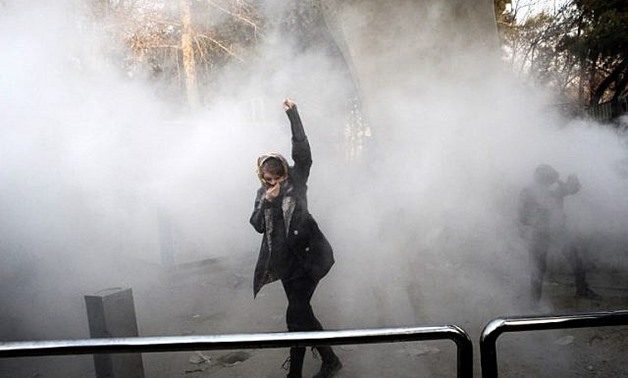
A woman raises her fist amid tear gas at the University of Tehran during a protest on December 30, 2017 - AFP
IRAN - 31 December 2017: Some 200 protesters marched through central Tehran Sunday as authorities braced for a possible fourth night of unrest and cut access to social media after days of unrest that saw two people killed.
A security deputy for Tehran's governor told the ILNA news agency that 200 people had been arrested after protests on Saturday night -- including 40 "leaders".
The interior minister warned that protesters will "pay the price" as footage on social media showed thousands marching across the country overnight in the biggest test for the Islamic republic since mass demonstrations in 2009.
The demonstrations began in second city Mashhad on Thursday over high living costs, but quickly spread and turned against the Islamic system as a whole, with slogans such as "Death to the dictator".
Lorestan province deputy governor Habibollah Khojastehpour told state television that two people were killed in clashes in the small western town of Dorud late Saturday, but denied security forces were responsible.
In an apparent attempt to stave off more unrest, the authorities began blocking access to photo sharing and online messaging services on mobile phones, including Telegram, which the government accused of being used to foment violence, local media and Telegram's CEO said.
The conservative-linked Fars news agency said around 200 people were taking part in the latest protest in Tehran.
"Contrary to rumours from hostile media, most parts of Tehran are calm. Around 200 people are occasionally chanting here and there," it said.
Fars said shops closed early Sunday "for fear of damage to their shops by rioters".
- 'Pay the price' -
After initial silence, state media has shown footage of unrest, focusing on young men violently targeting banks and vehicles, an attack on a town hall in Tehran, and images of a man burning the Iranian flag.
"Those who damage public property, disrupt order and break the law must be responsible for their behaviour and pay the price," Interior Minister Abdolrahman Rahmani Fazli said on state television.
"The spreading of violence, fear and terror will definitely be confronted," he added.
US President Donald Trump said the "big protests" showed people "were getting wise as to how their money and wealth is being stolen and squandered on terrorism".
"Looks like they will not take it any longer," he wrote on Twitter, warning that Washington is "watching very closely for human rights violations!"
Trump's ambassador to the UN, Nikki Haley, said Iran's government was "being tested by its own citizens".
Iranian authorities have sought to distinguish anti-regime protesters from what they see as legitimate economic grievances.
"Do not get excited," parliament director for international affairs Hossein Amir-Abdollahian wrote in a tweet directed at Trump.
"Sedition, unrest and chaos are different from gatherings and peaceful protests to pursue people's livelihoods," he said.
But there have been reminders of the continued support for the regime among conservative sections of society, with pro-regime students holding another day of demonstrations at the University of Tehran.
They had outnumbered protesters at the university on Saturday.
- Dozens arrested -
The total number of arrests from the protests around the country remained unclear.
Several hundred people were shown gathering in the western city of Kermanshah Sunday, according to footage shared online by a group linked to the powerful Revolutionary Guards.
An official in Arak, around 300 kilometres (190 miles) southwest of Tehran, said 80 people had been detained there overnight.
Police have so far taken a relatively soft approach to the unrest.
The authorities have blamed external forces for fomenting the protests, saying the majority of social media reports were emanating from regional rival Saudi Arabia or exile groups based in Europe.
President Hassan Rouhani has not yet made any statement since the protests started.
He came to power in 2013 promising to mend the economy and ease social tensions, but anger over high living costs and a 12-percent unemployment rate have left many feeling that progress is too slow.
Unemployment is particularly high among young people, who have grown up in a less restrictive environment and are generally considered less deferential to authority.
"Rouhani has run an austerity budget since 2013 with the idea that it's a tough but necessary pill to swallow to manage inflation and currency problems and try to improve Iran's attractiveness for investment," said Esfandyar Batmanghelidj, founder of the Europe-Iran Forum.
"But choosing years of austerity immediately after a very tough period of sanctions is bound to test people's patience," he told AFP.
Since the ruthless repression of the 2009 protests against a disputed presidential election that gave hardliner Mahmoud Ahmadinejad a second term, many middle-class Iranians have abandoned hope of securing change from the streets.
But low-level strikes and demonstrations have continued, with bus drivers, teachers and factory workers protesting against unpaid wages and poor conditions.


Comments
Leave a Comment